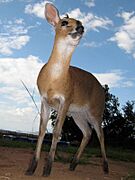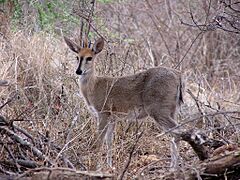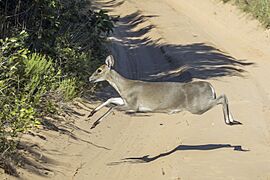Common duiker facts for kids
Quick facts for kids Common duiker |
|
|---|---|
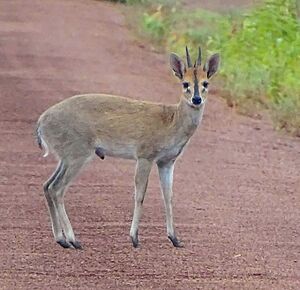 |
|
| Adult male in Pendjari National Park, Benin | |
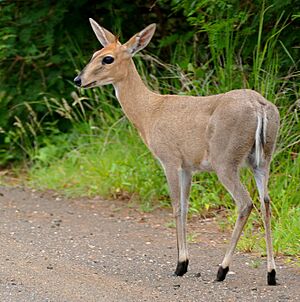 |
|
| Adult female in the Kruger National Park, South Africa | |
| Conservation status | |
| Scientific classification | |
| Genus: |
Sylvicapra
|
| Species: |
grimmia
|
| Synonyms | |
|
Capra grimmia Linnaeus, 1758 |
|
The common duiker (Sylvicapra grimmia) is a small antelope. It is also known as the gray duiker or bush duiker. This animal is the only member of its special group, called the Sylvicapra genus.
You can find common duikers almost everywhere in Africa. They live south of the Sahara desert. However, they are not found in the Horn of Africa or the thick rainforests of central and western Africa. These duikers usually live where there are lots of plants. This helps them hide. They like savannah areas and hills. You might even spot them near towns.
Contents
Discovering the Common Duiker: What Do They Look Like?
The color of common duikers changes a lot. It depends on where they live. There are 14 different types, called subspecies. Duikers in the forests of Angola might be chestnut brown. Those in northern savannas are often grizzled gray. In dry areas, they can be light brown.
Common duikers grow to be about 50 centimeters (20 inches) tall. They usually weigh between 12 and 25 kilograms (26 to 55 pounds). Female duikers are typically bigger and heavier than males. Only the male duikers have horns. These horns can grow up to 11 centimeters (4.3 inches) long.
Life of a Common Duiker: Habits and Diet
Common duikers can have babies all year round. The female gives birth to one baby, called a fawn. This happens after she is pregnant for 6 to 7.5 months.
What Do Common Duikers Eat?
Common duikers eat many different things. They munch on leaves, flowers, fruits, and roots. But their diet is even more varied! They also eat insects, frogs, small birds, and even tiny mammals. Sometimes, they will even eat dead animals.
They can go a long time without drinking water. This is because they get water from the plants they eat. During the rainy season, they often do not drink water at all. Instead, they get all the fluids they need from juicy fruits. They often look for these fruits under trees where monkeys are eating.
Daily Life and Territory
Common duikers are active both during the day and at night. However, near human towns, they tend to be more active at night. This is probably because of people and stray dogs.
Male duikers like to have their own space, called a territory. They rub special gland secretions on rocks and branches to mark their area. They often rest on high ground. This lets them watch over their territory. Female duikers, however, prefer to hide in thick bushes.
This species is very successful. They can live in many different types of places. Also, they can eat a wide variety of foods. This makes them very adaptable.
Gallery
-
young male in Kruger Park



